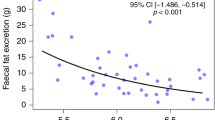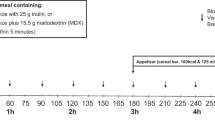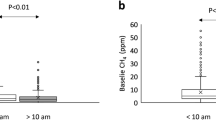Abstract
Objective:
In this study, the duration of enzyme induction provoked by unlabelled lactose ureide (LU) in orocaecal transit time (OCTT) measurements with lactose-[13C]ureide (13C-LU) was evaluated.
Design:
Experimental study.
Setting:
University of Rostock, Children's Hospital, Research Laboratory.
Subjects:
Fifteen healthy adults aged 19–54 years.
Intervention:
One-half gram of 13C-LU was administered together with a continental breakfast. After 1 week, the test was repeated after pre-dosing of 5 × 100 mg LU on the day before the study began. The 13C-LU ingestion was repeated under identical conditions but without pre-dosing 1 and 3 weeks after pre-dosing. Expired air samples were taken over 14 h. 13CO2-enrichment was measured by isotope ratio mass spectrometry (SerCon, Crewe, UK). The OCTT was calculated from the interval between 13C-LU administration and the detection of a significant and sustained 13C-rise of 2 delta over baseline in breath.
Results:
Without pre-dosing, an OCTT of 419±82 min was measured. The pre-dosing resulted in higher 13C-enrichments and caused a significant OCTT shortening of 311±99 min (P=0.028). One and 3 weeks after pre-dosing, the measured OCTT again increased to 404±124 and 379±103 min, respectively.
Conclusions:
Pre-dosing with LU before pulse labelling with 13C-LU led to an induction of enzyme activity and resulted in a definitive estimation of the OCTT when using a threshold of 2 delta over baseline. After 1 and 3 weeks, respectively, the OCTT was no longer significantly different to those without pre-dosing, indicating the disappearance of enzyme induction. Therefore, a pre-dosing with LU on the day before 13C-LU ingestion is essential for OCTT measurements.
This is a preview of subscription content, access via your institution
Access options
Subscribe to this journal
Receive 12 print issues and online access
$259.00 per year
only $21.58 per issue
Buy this article
- Purchase on Springer Link
- Instant access to full article PDF
Prices may be subject to local taxes which are calculated during checkout


Similar content being viewed by others
References
Barrie A, Davies JE, Park AJ, Workmann CT (1989). Continuous-flow stable isotope analysis for biologists. Spectroscopy 4, 42–52.
Christian M, Morrison D, Dodson B, Preston T, Amarri S, Franchini F et al. (2002). Measurement of oro-cecal transit time in young children using lactose [13C] ureide requires further validation. J Pediatr Gastroenterol Nutr 34, 570–571.
De Preter V, Geboes K, Verbrugghe K, De Vuyst L, Vanhoutte T, Huys G et al. (2004). The in vivo use of the stable isotope-labelled biomarkers lactose-[15N]ureide and [2H4]tyrosine to assess the effects of pro- and prebiotics on the intestinal flora of healthy human volunteers. Br J Nutr 92, 439–446.
Geboes KP, De Preter V, Luypaerts A, Bammens B, Evenepoel P, Ghoos Y et al. (2005). Validation of lactose[15N,15N]ureide as a tool to study colonic nitrogen metabolism. Am J Physiol 288, G994–G999.
Geypens B, Bennink R, Peeters M, Evenepoel P, Mortelmans L, Maes B et al. (1999). Validation of the lactose-[13C]ureide breath test for determination of orocecal transit time by scintigraphy. J Nucl Med 40, 1451–1455.
Heine WE, Berthold HK, Klein PD (1995). A novel stable isotope breath test: 13C-labelled glycosyl ureides used as noninvasive markers of intestinal transit time. Am J Gastroenterol 90, 93–98.
Jackson AA, Bundy R, Hounslow A, Murphy JL, Wootton SA (1999). Metabolism of lactose-[13C]ureide and lactose-[15N,15N]ureide in normal adults consuming a diet marginally adequate in protein. Clin Sci 97, 547–555.
Jackson AA, Gibson NR, Bundy R, Hounslow A, Millward DJ, Wootton SA (2004). Transfer of 15N from oral lactose-ureide to lysine in normal adults. Int J Food Sci Nutr 55, 455–462.
Leitzmann P, Heine W, Wutzke KD, von Bismarck P, Dorlöchter L, Miera O et al. (1998). Blood glucose, gastric emptying, and oro-coecal transit time after a conventional breakfast vs. a Kollath breakfast. Z Ernährungswiss 37, 31–37.
Mohr C, Heine WE, Wutzke KD (1999). Clostridium innocuum: a glucose ureide splitting inhabitant of the human microbial flora. Biochim Biophys Acta 1472, 550–554.
Morrison DJ, Dodson B, Preston T (1999). Measurement of urinary total 13C and 13C urea by isotope ratio mass spectrometry after administration of lactose [13C]-ureide. Rapid Commun Mass Spectrom 13, 1252–1256.
Morrison DJ, Dodson B, Preston T, Weaver LT (2003). Gastrointestinal handling of glycosyl [13C]ureides. Eur J Clin Nutr 57, 1017–1024.
Morrison DJ, Zavoshy R, Edwards CA, Dodson B, Preston T, Weaver LT (1998). Lactose [13C]Ureide as a marker for colonic fermentation and the deconvolution of a complex 13CO2 breath test curve. Biochem Soc Trans 26, 184.
Ruemmele FM, Heine WE, Keller KM, Lentze MJ (1997). Metabolism of glycosyl ureides by human intestinal brush border enzymes. Biochim Biophys Acta 1336, 275–280.
Sarno S, Erasmus LP, Haslbeck M, Holzl R (1993). Orocaecal transit-time by the H2 method: effects of definitions of caecal entry and test meal. Ital J Gastroenterol 25, 55–64.
Schoeller DA, Klein PD, Watkins JB, Heim T, MacLean Jr WC (1980). 13C abundances of nutrients and the effect of variations in 13C isotopic abundances of test meals formulated for 13CO2 breath tests. Am J Clin Nutr 33, 2375–2385.
Van den Driessche M, Van Malderen N, Geypens B, Ghoos Y, Veereman-Wauters G (2000). Lactose-[13C]ureide breath test: a new, noninvasive technique to determine orocecal transit time in children. J Pediatr Gastroenterol Nutr 31, 433–488.
Wutzke KD, Heine WE, Plath C, Leitzmann P, Radke M, Mohr C et al. (1997). Evaluation of oro-coecal transit time: a comparison of the lactose-[13C, 15N]ureide 13CO2- and the lactulose H2- breath test. Eur J Clin Nutr 51, 11–19.
Wutzke KD, Glasenapp B (2004). The use of 13C-labelled glycosyl ureides for evaluation of orocaecal transit time. Eur J Clin Nutr 58, 568–572.
Wutzke KD, Oetjens I (2005). C- and 15N-incorporation of doubly stable isotope labelled Lactobacillus johnsonii in humans. Eur J Clin Nutr 59, 1167–1172.
Wutzke KD, Sattinger V (2006). 15N-excretion of heat-killed Lactobacillus casei in humans. Eur J Clin Nutr 60, 847–852.
Author information
Authors and Affiliations
Corresponding author
Additional information
Guarantor: KD Wutzke.
Contributors: MS was principal investigator and doctoral candidate of KDW.
Rights and permissions
About this article
Cite this article
Wutzke, K., Schütt, M. The duration of enzyme induction in orocaecal transit time measurements. Eur J Clin Nutr 61, 1162–1166 (2007). https://doi.org/10.1038/sj.ejcn.1602633
Received:
Revised:
Accepted:
Published:
Issue Date:
DOI: https://doi.org/10.1038/sj.ejcn.1602633
Keywords
This article is cited by
-
The metabolic fate of doubly labelled lactose-[13C, 15N]ureide after pre-dosing with different ureides
European Journal of Clinical Nutrition (2010)
-
The effect of pre- and probiotics on the colonic ammonia metabolism in humans as measured by lactose-[15N2]ureide
European Journal of Clinical Nutrition (2010)



